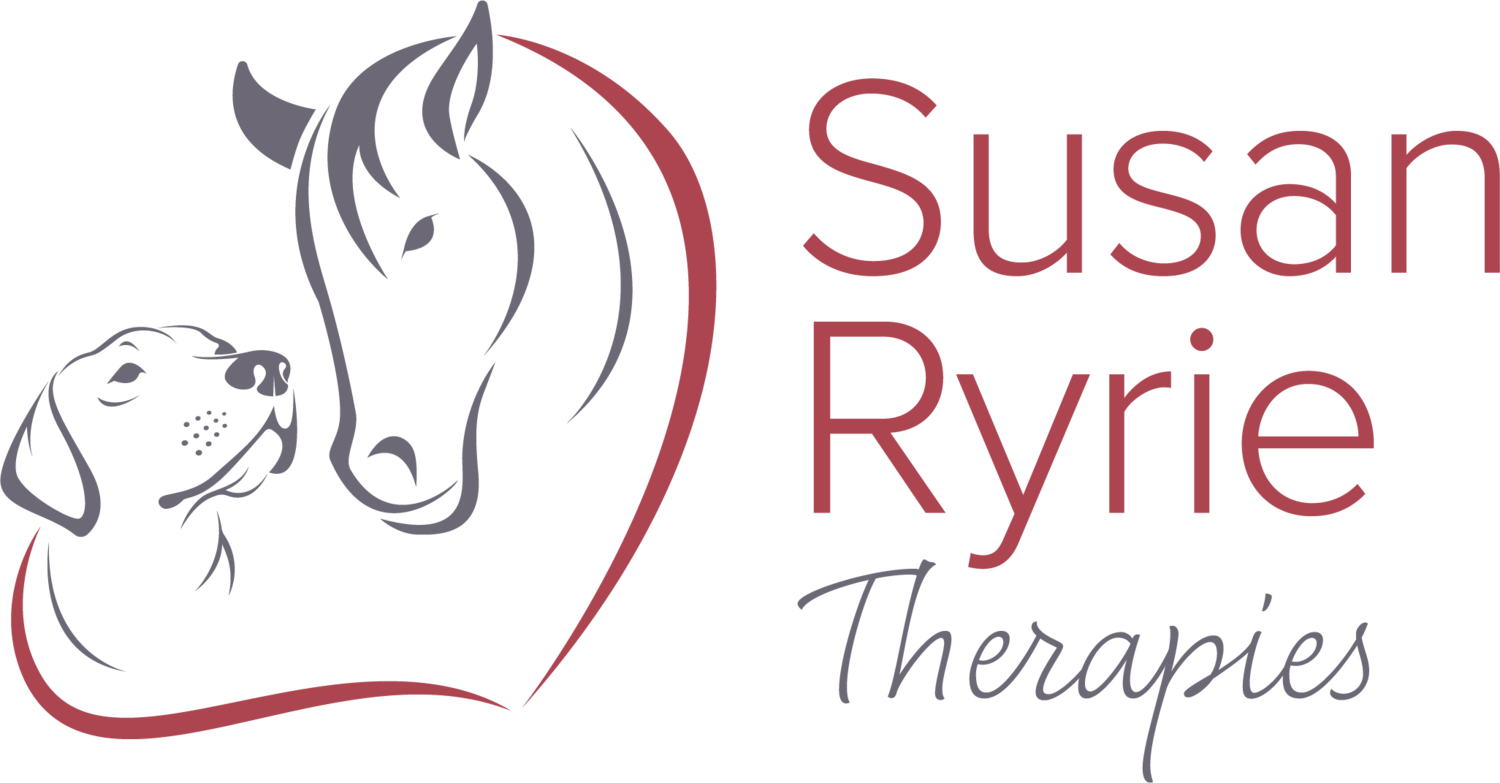March 2024
Polework exercises - great for dogs as well as horses!
Polework clinics are popular. Working with your horse over ground poles can add fun and interest to any arena session. It brings many benefits when done well; but take care because it has a darker side, and can be damaging if not done well!

Poles can be used as a cue for better movement. Since improvements are achieved progressively, the polework exercises must be chosen to match the ability and needs of the individual horse at that particular time.
‘Clambering’ through an arrangement that is too difficult will encourage compensations and an overall deterioration in the quality of movement – just the opposite of what we want.
Repetition is part of the process, and the development of good habits of movement must be our aim, but of course repetition will also reinforce bad habits. It is important to choose exercises that correct poor patterns of movement.
Alongside asking for sufficient repetition to build habit, we must also beware of causing muscle fatigue and damage as a result of too much repetition. It could be a real mine field, but a bit of common sense and awareness of the pitfalls will take you a long way. As always, play safe by starting with easy exercises and build up the level of difficulty gradually. As for how many repetitions to use, a good general rule of thumb to follow is 5 – 10 repetitions, but only once the horse is able to complete the exercise fluently.
Fun and interest are associated with ‘paying attention’, and that brings us to the first benefit of working with ground poles – improvements in proprioception. Simply put, proprioception is your horse’s ability to sense what each part of the body is doing, even if it is out of sight.
When you work with your horse over ground poles, or low raised poles, your horse needs to focus on where each foot is landing, and also the flight arc between each ground contact. This is a great way to boost proprioception.
To experience your own sense of proprioception, clap your hands above your head; fasten the catch on a pendant; yes, ladies, do up your bra. All of these actions require you to have good control of your hands even when you cannot see them.
Proprioception can be adversely affected by injury, and can decline with age. Practicing exercises that engage proprioception can help maintain good control of muscles, posture and balance.
Working over poles can also engage and strengthen the abdominal muscles.
The horse will naturally want to reach up and forward with the hind legs in order to clear the pole. This is not possible if the back is hollowed, because the angle at which the pelvis is held ‘gets in the way’. The horse is therefore encouraged to engage the abdominal muscles in order to round his back and bring the hind legs through.
To experience this yourself, go onto all fours on the floor. Hollow out your back (be careful – don’t exaggerate this too far and cause yourself any discomfort). Now try to bring one knee towards your chin. Next, lift and round your back upwards, then bring your knee towards your chin. This time it should be much easier and you should find you can reach much further.
It is important that a horse’s abdominal muscles are strong enough to lift the horse’s back even when it is carrying the weight of the rider.
The thoracic sling is a group of muscles within the horse’s front quarters. These muscles suspend the weight of the torso between the front legs - horses do not have a clavicle (collar bone) to attach the front legs to the rest of the trunk.
As a horse lifts its front legs over an obstacle such as a pole on the ground, it will naturally engage the thoracic sling to make space for the leg to move upwards; it will also naturally shift its weight back just a little.
Both of these effects help the horse to carry the weight of a rider, and so exercises which strengthen the muscles involved are very beneficial.
Engagement vs. strengthening?
Engagement refers to an activation of muscles – it is like pressing the ‘on’ switch.
There is a difference between the process of switching a muscle on (engagement) and the process of the muscle working. Switching a muscle on – engaging it – asking it to work – is the first element which will lead to the effort that produces strengthening.
Repeatedly asking the body to engage appropriate muscles builds a habit of engagement. Each time the horse approaches the poles it will be encouraged to ‘switch on’ postural muscles in this way. As it leaves the configuration, it is likely to relax the effort involved, allowing the muscles to ‘switch off’ to some extent.
Over time, key postural muscles will be engaged more frequently and more fluently, they will work for longer periods of time and will become stronger.
It is natural to think that a faster pace will involve more muscular effort than a slower pace. However, trotting over poles actually is less physical effort for the horse than walking – though it may be more of a proprioceptive challenge because of the speed.
So why is trotting ‘easier’? It is all to do with the suspension phase of trot, where all four feet are momentarily off the ground. As a foot lands in trot, gravitational energy is absorbed and stored in tendons, ligaments and fascia, then released again to assist in propulsion of the next stride. This is much like the way a ‘pogo stick’ works.
Think of a spring alternating between absorbing energy, then ‘unleashing’ it. In trot, your horse is literally bouncing along! Energy is stored then released, so reducing the amount of force that muscles need to generate. The walk however, relies much more on muscular effort.
Any exercise that involves correct placement of the feet will benefit proprioception, no matter how little or how often it is repeated – though of course more will bring greater benefits. However, when it comes to benefits of engagement, strengthening, and formation of habits or correct movement, repetition of the exercise within each session is a must. Typically you should aim for around ten repetitions provided the exercise is at the correct level for the horse. If you are introducing a new exercise at a greater level of challenge, you would be better to start with fewer repetitions to begin with.
With any type of exercise, it is important to avoid overworking both the muscles and the nervous system. Fatigue is a sign that muscle damage is starting to occur. Without care, this could develop into a significant training injury that could lead to long term difficulties. Fatigue can also lead to loss of balance and coordination, making an injury more likely.
In addition, as soon as the ‘correct’ muscle begins to fatigue, the body will begin to compensate, and recruit alternative muscles to perform the movement. If you keep working in this situation, you will just be reinforcing unhelpful, even damaging, patterns of compensation.
To avoid these problems, always introduce new exercises at the easiest possible level. In the case of polework, horses should always learn a new layout with poles placed on the ground. Start with a small number of repetitions so that the nervous system can learn the correct coordination. Then over the course of a week or two increase the number of repetitions to gain a greater strengthening effect. Finally, one your horse is very fluent with the poles arranged on the ground, you can increase the challenge further by raising them a little – 4” to 8” is an appropriate height to use.

A horse will need to bend its legs more in order to step over higher poles. So building up to be able to work with raised poles can increase the range of movement of joints in the legs. This is good for joint health, but, as with everything else, do build up the challenge gradually in order to get the greatest benefits with the smallest chance of negative side effects.
Poles laid out in a grid ensure that the horse takes a correct, even, and rhythmic stride. But this can only happen if you have placed the poles accurately. For a walk stride, you should aim for a spacing of between 2½ and 3 feet. There is a reason why a ‘foot’ has been referred to as a ‘foot’; assume that your boot size is around 12 inches and measure the distance by placing heel to toe between the poles. Check the spacing is accurate throughout your grid. Walk your horse through. A grid of five poles is long enough for you to spot if the stride length is a little too long or too short for your horse, so go back and adjust as necessary. Once you have got it worked out, you might find a measuring stick helps you lay future grids more quickly, for example an appropriate length of garden cane.
The length of a trot stride is approximately 1½ times the length of a walk stride – use a second length of garden cane.
The geometry of a straight grid of poles is identical to the left and to the right. This makes it difficult for your horse to move in any way that is not symmetric, such as weighting the left leg more than the right, throwing the left shoulder outwards, moving with a slight bend in one direction, dragging one foot. So polework is a way of repeating more correct movement, and retraining correct movement.
Be aware that where you recognise that your horse is moving incorrectly, it could be caused by:
· Poor habits
· Patterns of compensation
· Muscle weakness
· Muscle tension
· Injury
Where you see significant departures from correct, straight movement you should always seek professional advice.
We can retrain movement patterns by repeating an exercise using poles to influence the way the horse’s body moves. Because of this element of repetition, we need to take care that we are not training poor habits of movement. This is a real danger with polework exercises. Although it can be tempting to move ahead quickly, make sure that your horse is very fluent with the easiest version of any exercise before moving ahead. Don’t just listen for the feet knocking a pole, watch as someone else takes your horse through the exercise, or take a video if you are working alone and watch it at home. Especially, look at the movement of the hind legs. If they trail behind, then the horse is not ready to progress. And remember not to repeat so many times that the horse becomes sour with the exercise, of shows signs of fatigue.

Pole work exercises are great when used correctly. Have a go – don’t be overly ambitious – and have fun!












